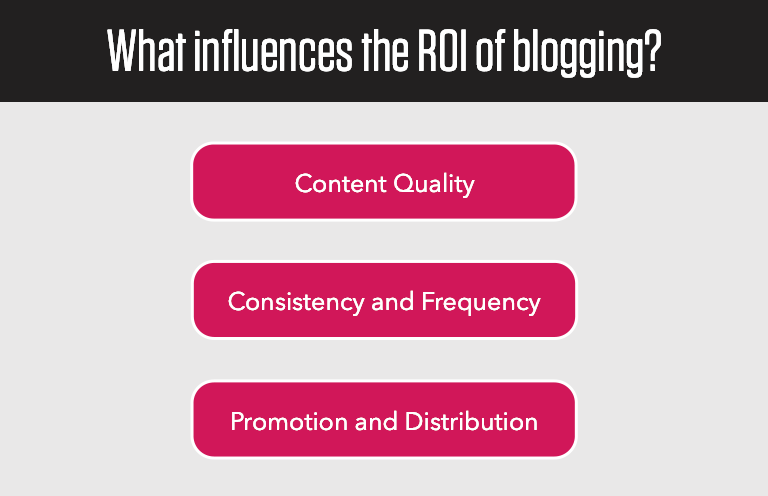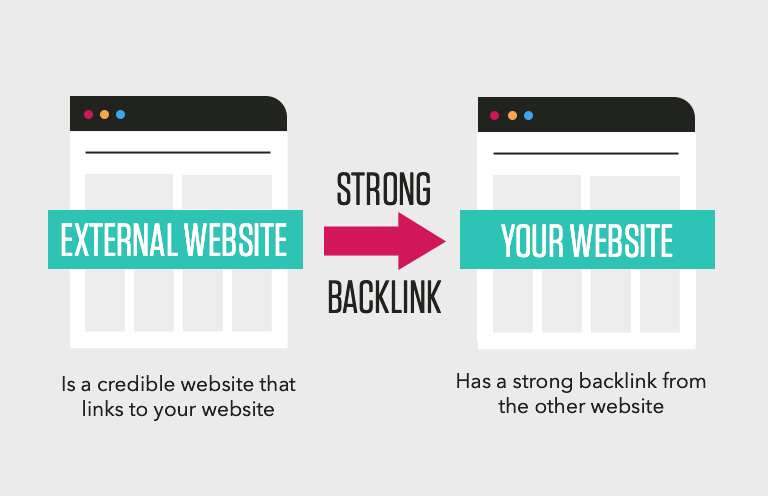
Blogging is one of the elder statesmen of digital marketing. It’s been around a LONG time and has been used by many businesses over the past two decades.
But is blogging still a viable business strategy in 2024? With all the different digital marketing platforms available, is blogging worth the time and effort required? What is the ROI of blogging?
In this article, we explore the potential ROI of blogging and determine why it is still a relevant strategy for businesses in 2024.
The ROI of Blogging
What is the ROI of blogging in 2024? Consider these statistics:
- Companies that blog generate, on average, 67% more leads than those that do not blog
- Websites with blogs have 97% more inbound links (and thus higher rankings) than those without blogs
- Companies with blogs get 55% more visitors than those without blogs
- 70% of people would prefer to learn about a company through articles rather than advertisements
Numerous companies have proven these statistics. SaaS juggernauts like Drift, Intercom, Monday.com, and HubSpot have built billion-dollar businesses on the back of their blogging efforts. Companies like Buffer and Ahrefs have built their brand personalities and attracted passionate audiences through blogging.
The bottom line is that blogging works for businesses. It allows them to generate more leads, more traffic, more sales, and more revenue.
Understanding the ROI of Blogging
To understand the ROI of blogging, you need to look at it holistically. You need to examine both the tangible benefits as well as the intangible benefits.
Tangible benefits include things we’ve already touched on, like increased leads, sales, traffic, and revenue. These are all quantifiable metrics that directly impact the bottom line.
Intangible benefits, on the other hand, are more difficult to measure but can have just as much of an impact. These include things like brand awareness, thought leadership, and customer loyalty.
Blogging allows a company to establish itself as a trusted authority in its industry, which can lead to increased brand recognition and more customer engagement.
68.5% of consumers say that a blog adds credibility to a website. Additionally, blogs are a trusted source of information and advice for a whopping 81% of US consumers.
These statistics shouldn’t be surprising. A blog allows a brand to demonstrate its expertise, authority, and trustworthiness. It enables companies to speak directly to the pain points and desires of their audience and provide valuable solutions and insights.
Google increasingly wants to serve up search results that demonstrate Experience, Expertise, Authority, and Trustworthiness. Through regular blogging, brands can demonstrate these qualities, ultimately resulting in higher search rankings.
Factors Influencing The ROI Of Blogging
It’s important to note that not all blogs and blog posts are created equal. There are a number of key factors that influence the ROI of blogging.
First and foremost is content quality. Few, if any, factors are more important than the quality of content on a blog. The blogs with the highest ROI consistently publish high-value, in-depth content that speaks to users at every stage of the funnel.
This content should be well-researched, informative, and engaging. It should answer specific questions being asked by users and show how the brand’s product or service helps solve customer problems.
71% of B2B buyers consume blog content at some point during the buyer’s journey. If you want to attract and convert those B2B buyers, your blog content must be of the highest quality.
The average length of a blog post is 1,416 words. And while there’s no hard and fast rule about how long your content must be, it’s safe to say that it should be at least that long, if not longer. Generally speaking, long-form content tends to perform better in SEO and generate more social media shares.
Second, consistency and blogging frequency play a crucial role in the success of a blog. Brands that publish new content regularly are more likely to see higher traffic and engagement on their blog. It’s important to establish a regular publishing schedule and stick to it.
According to OptIn Monster, marketers who prioritize blogging are 13x more likely to have a positive ROI on their efforts. Additionally, blogs that publish between 2 – 6 blog posts per week are 50% more likely to report strong results.
Third, content promotion, content atomization, and distribution methods can greatly impact the success of a blog and its ROI. Simply publishing content is not enough – it’s important to use various marketing strategies like social media, email marketing, and backlink building to amplify your reach and attract more readers.
Lead Generation Through Blogging
One specific area where you can see the ROI of blogging is lead generation. Blogging is particularly effective for lead generation because it allows you to attract and engage potential customers in a non-intrusive way. By creating valuable content that addresses their pain points and provides solutions, you can establish your brand as an authority and build trust with your audience.
HubSpot reports that 88% of bloggers who gate some content report some/strong results from blogging. In other words, by gating some of your blog content, you can capture valuable lead information and use it to nurture them into becoming paying customers.
GrooveHQ reports that 10% of subscribers to their blog convert to a free trial of their software, compared to just 5% of those who don’t subscribe.
How can you use your blog to generate leads for your brand? It starts by producing high-value content that draws readers in. This is a non-negotiable. Without quality content, none of your other efforts will be successful.
Assuming you have great content, one of the best ways is through the strategic use of Calls-To-Action (CTAs). CTAs should be both contextual and varied. In other words, they should relate directly to what you’re speaking about in a blog post and should provide multiple opt-in options for users.
For example, at the top of a blog post, you may offer users a link to another related blog post. Further down, you may include a link to a relevant case study. At the bottom, you might give users the opportunity to sign up for your email list.
This cascading use of CTAs assumes that readers who make it to the bottom of a blog post are more likely to sign up for an email list. They have demonstrated interest in what the company offers and the odds are higher that they’ll willingly give you their email address.
Increased Website Traffic and SEO Through Blogging
Few things are better for increasing website traffic and boosting SEO than blogging. In fact, 72% of digital marketers say that content creation is their most effective SEO tactic. Additionally, a blog increases your chances of ranking by an incredible 434%.
Blogging enables you to target high-value keywords and topics related to your industry, products, or services. This helps drive organic traffic to your site through search engines. Companies that publish at least 16 blog posts per month get 3.5X more traffic than those that publish fewer than four posts.
Additionally, blogging allows you to build topical authority, in which you demonstrate your expertise and authority related to an entire topic rather than just a single keyword. The more you build topical authority, the higher you’ll rank for all keywords related to that topic.
But it’s not just about driving traffic to your website, it also has the potential to bring in high-quality leads that are more likely to convert. Leads from SEO have a 14.6% close rate, compared to a mediocre 1.7% close rate for leads gained through outbound marketing.
Why is the SEO lead close rate so much higher than outbound marketing? One reason is that SEO allows you to attract a targeted audience who have demonstrated an interest in what you’re offering.
You can create content that is optimized for highly specific keywords that have buyer’s intent. This means that your content is more likely to appear in front of people who are actively searching for what you have to offer rather than coming across it through a cold outreach email or social media post.
Blogging for Revenue Growth
Blogging can be a powerful tool for driving revenue growth. It allows you to create content that speaks to users at every stage of the customer journey. For users at the top of the marketing funnel (TOFU), blogging can create brand awareness and establish your business as an authority in your industry.
As users move down the funnel to the middle (MOFU) blogging can be used to educate and nurture leads, helping them better understand their pain points and how your product or service can solve them.
Finally, for users at the bottom of the funnel (BOFU), blogging can be used to showcase testimonials, case studies, and other social proof that demonstrates the effectiveness of your offerings. This can help push those leads toward making a purchase decision.
Additionally, blogging can be used to help retain customers and reduce customer churn. By consistently providing valuable and relevant content, you can keep your customers engaged and happy, reducing the likelihood of them seeking out a competitor’s solution.
The Power of Backlink Acquisition Through Blogging
Backlinks play a critical role in SEO ROI. All things equal, more links back to your website translate into higher search rankings across the board. Blogging is a powerful, effective way to acquire backlinks to your website.
Why?
Because blogging allows you to create link-worthy pages. The reality is that most of the pages on your website, like your home page, product pages, etc., are not going to attract a lot of backlinks. There just isn’t much reason for people to link to those pages unless they’re specifically referencing them.
Blogging, on the other hand, allows you to create content that is valuable and that people want to link to. As we noted above, companies that blog receive 97% more backlinks than companies that don’t blog.
So, how do you create link-worthy content? Here are a few tips:
- Provide unique and valuable information that people can’t find elsewhere. This could be original research, expert opinions, or data analysis.
- Create visually appealing content that is easy to read and digest. Use images, videos, infographics, and other multimedia elements to break up the text and make your content more engaging.
- Write about timely, trending topics that are relevant to your industry or audience. This will increase the chances of others sharing and linking to your content on social media and other platforms.
- Collaborate with other bloggers, influencers, and thought leaders in your industry to create guest posts or participate in round-up articles. This can help you reach a wider audience while also building relationships and earning valuable backlinks.
- Offer solutions to common problems or challenges faced by your target audience. This will not only establish you as an expert in your field, but it can also generate buzz and discussion, leading to more links and shares.
As your content begins to attract more backlinks, it will steadily climb in the search rankings. This, in turn, leads to even more backlinks, which leads to higher rankings, and so on. It’s a virtuous cycle.
At Stratabeat, a B2B content marketing agency, we call our backlink-building strategy “passive backlink building.” By this, we mean that creating content so good that it naturally attracts backlinks without requiring active outreach.
This was the strategy we used to help one Fortune 1000 company increase its organic traffic by 7,235.7%. We focused on creating content so good that people couldn’t help but link to it. Over time, as more and more content received backlinks and ranked in the SERPs, the domain authority of the site increased from 35 to 72.
Influencing Decision Makers and Industry Trends Through Blogging
Blogging is uniquely positioned to influence decision-makers and industry trends. By creating content that speaks to the pain points and challenges of your target audience, you can showcase your expertise and thought leadership. You can help answer the specific questions and challenges that your audience is facing and help them achieve their goals.
As we noted above, 71% of B2B decision-makers consume blog content at some point in the marketing funnel. Additionally, almost 50% of decision-makers view between 3-5 pieces of content before engaging with a sales rep.
When you have a high-value blog that serves as a central resource hub, you increase the chances of connecting with those decision-makers and persuading them to purchase from you.
Additionally, consistently producing high-quality and relevant content can establish your brand as a go-to resource in the industry. Decision-makers will often turn to these resources for insights and information when making important decisions.
Beyond just influencing decision-makers, blogging can also shape industry trends. By addressing emerging topics and challenges in your field, you can establish your brand as a thought leader and influencer.
As people discover and share your content, you can start to shape the conversation around those topics and become a go-to source for industry insights.
How to Measure and Maximize the ROI of Blogging
Calculating the ROI of blogging can be tricky and involves multiple metrics. To start, you need to calculate the costs involved in producing the blog posts. This should include:
- Employee salaries for those involved in managing, writing, designing, and editing the blog
- Overhead for those employees
- Costs for freelancers and contractors
- Development costs
- Content management and SEO software
Next, you need to calculate the return on investment by tracking metrics such as:
- Website traffic
- Conversions
- Social media engagement and followers
- Increase in leads or sales directly attributed to the blog
To calculate ROI, you need to determine how much each metric contributes toward revenue. This is easier with some metrics than others. For example, if you generate 100 leads, and 10% of your leads convert to customers, and each customer earns you $100, your blogging ROI would be:
(100 leads x .10) x $100 = $1,000 in revenue from your blog.
Determining the exact calculation may not be simple, but Google Analytics, your CMS platform’s analytics dashboard, and various data tracking methods can help you determine the impact of your blog on your business and evaluate its overall effectiveness.
It’s essential that your blogging efforts are aligned with your business objectives. If they’re not, blogging becomes an exercise in vanity. For example, if your business objective is to increase MRR by $10,000, it doesn’t really help you to increase the number of social media followers you have. You want to ensure that your blogging is contributing directly to your MRR.
Drive Your Audience to Action
Build authoritative B2B blogs that resonate with your target audience. Book a Strategy CallThe Future of Blogging ROI
There are several key trends that will affect the ROI of blogging. First, as AI and automation continue to evolve, we should expect to see a proliferation of generic, TOFU content that only speaks to customer pain points at a very generic level.
To differentiate themselves amidst the sea of content, businesses will need to double down on creating ultra-high-quality blog content that speaks to pain points at an expert level.
This could potentially increase both the cost and ROI of blogging. Yes, the content will cost more to create but its value will also be higher, leading to increased conversions and revenue. Companies that invest in creating high-quality, expert-level blog content will likely see a better content marketing ROI than those that stick with generic, low-cost content.
Second, we should expect to see ChatGPT take a portion of longtail searches by providing quick, accurate, conversational responses to detailed search queries. Users may not need to visit a blog to get an answer to their question, depending on the level of complexity. Rather, they can get a detailed answer directly from ChatGPT.
To keep from losing their lunch to ChatGPT, brands should focus on answering in-depth questions that can’t be easily answered by a chatbot. These in-depth questions will most likely be middle to bottom-of-the-funnel-type queries, making them more likely to lead to conversions.
Brands should also focus on creating blog content that appeals to human emotions and connects with readers on a personal level. While ChatGPT may be able to provide quick answers, it lacks the personal touch and emotional connection that humans crave.
Summary
It’s undeniable that blogging has a solid ROI. It is a viable strategy for increasing brand awareness, boosting web traffic, driving more leads, generating more sales, and ultimately boosting the bottom line.
Even as digital marketing rapidly evolves, blogging remains a valuable tool in a company’s marketing arsenal. It allows businesses to showcase their expertise, build credibility and trust with their audience, and establish a strong online presence.
Do you want to increase your blogging ROI and make your blog a juggernaut that drives traffic, increases SERP rankings, and generates leads? If so, consider working with an experienced B2B SaaS content marketing agency like Stratabeat. We’ve helped multiple businesses turn their blogs into successful lead-generation machines. Let us help you achieve the same results.
Related Posts




